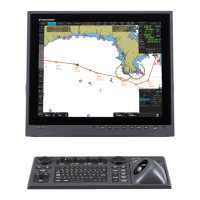26. AUTOPILOT OPERATIONS
26-27
7. When the vessel passes the WOL, the ECDIS releases the Course Change Alarm
(CCA), which is the Alert "152 Wheel Over Line".
8. The CCA is not acknowledged.
9. 30 seconds after the vessel passes the WOL, the ECDIS outputs the Backup Nav-
igator Alarm (contact signal, N/O or N/C) to the BNWAS.
10. The CCA is acknowledged.
11. The ECDIS stops the Backup Navigator Alarm and resets the contact signal.
IEC 62065 Ed. 2.0
1. The vessel’s position is 240 seconds from the WOL.
2. The ECDIS releases the Early Course Change Warning (ECCW), which is the
Alert "150 Early Course Change Indication".
3. The ECCW is acknowledged.
4. The vessel’s position is 30 seconds from the WOL.
5. The ECDIS releases the Actual Course Change Warning (ACCW), which is the
Alert "151 Actual Course Change Indication".
6. The ACCW is not acknowledged.
7. 30 seconds after the vessel passes the WOL, the Warning is upgraded to Alarm
and the ECDIS releases the Actual Course Change Alarm (ACCA), which is the
Alert "151 Actual Course Change Indication".
8. The ACCA is not acknowledged.
9. 30 seconds later, the ECDIS outputs the Backup Navigator Alarm to the BNWAS.
The output is comprised of a contact signal (N/O or N/C) and the ALR sentence.
$TCALR,,260,A,V,Emergency Call*0C<CR><LF>
10. The ACCA is acknowledged.
11. The ECDIS stops the Backup Navigator Alarm, resets the contact signal and out-
puts the ALR sentence to the BNWAS.
$TCALR,,260,A,A,Emergency Call*1B<CR><LF>
Note: The Backup Navigator Alarm is automatically stopped if the TCS is stopped be-
fore the Backup Navigator Alarm is acknowledged.
㪮㪦㪣
ACK
No ACK
90 sec.
before WOL
30 sec.
before WOL
No ACK
30 sec.
after WOL
(1) ECCI
released
(2) CCI
released
(3) CCA
released
(4) Backup
navigator alarm
released

